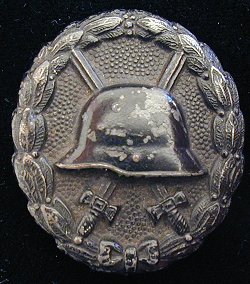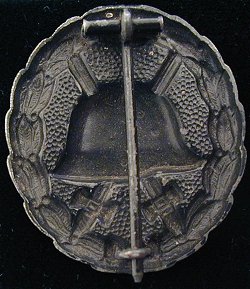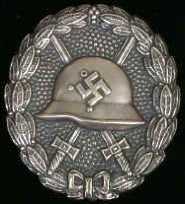
by Sebastián J. Bianchi
Imperial Wound Badge
The history of the German wound badge dates back to World War I. Kaiser Wilhelm II established the first German Military Wound badge (Verwundetenzbzeichen) on March 3rd, 1918, with a the declaration stating that it would be presented in 3 grades. It was to awarded in black for one to two wounds, in silver for three to four wounds, and in gold for five wounds or more. In cases of severe wounds the higher class was presented. The Imperial Wound badge was to provide the basis for ones issued during World War II. It was an oval badge with laurels surrounding the edges and a ribbon at the base. In the center of the badge is an Imperial helmet, with a pair of swords behind it. The background of the center is pebbled, though in one variation the background of the badge is hollowed. The silver grade of the Imperial Wound badge is pictured to the right.
 |
 |
Sebastián Bianchi Collection |
|
On June 3rd, 1918, the Bavarian War Ministry declared that the Wound Badge was an “award”, not a “decoration”, and on June 24th the Kaiser introduced the Naval Wound Badge, which was to be awarded in the same grades as the Army and under the same regulations. Due to the late nature of the creation of the award in relation to the war, many soldiers who were wounded never received their badges, a situation that was not fully remedied until after the collapse of the Weimar Republic.
On January 30th, 1936, with Hitler in power and the Army gaining full momentum , the Ministry of Interior issued a declaration stating that all those who were wounded during World War I and never received their Wound Badge could now do so through the proper channels. They would also receive the proper documents, which would in turn allow them to wear the badge officially and in public. Still on April 20, 1939, after the annexation of Austria, the Sudetenland, and Memel, the Ministry of interior issued a declaration stating that all those who served in the Austro-Hungarian Army and were wounded in action during World War I would also be able to receive the award. In fact, these awards were presented until late 1941.
Condor Legion Wound Badge
The Condor Legion who fought in Spain in 1936-1939 did not have a wound badge, or any other award during the conflict. Upon their return to Germany after the victory of the forces guided by Gen. Franco, however, Condor Legion, or Spanish Wound Badge, was established on May 22, 1939. Its regulation stated that it was created...
“..as a recognition badge to German Volunteers who had received wounds on action in the fight again Bolshevism during the 1936-1939 Spanish War of Liberation”.
All three classes were renewed, but the gold wound badge was not presented, as there was apparently no one that qualified to receive it. The Condor Legion Wound Badges were exactly like to the World War I wound badges (these dies were readily available) with the addition of a swastika on the Imperial Helmet. They were always hollow backs with the swastika high on the helmet, sharply defined, and flushed with the helmet. The award was now all-inclusive so no separate Wound Badge was created for the Kriegsmarine. It was possible for members of the Wehrmacht who were later wounded in the Second World War to receive the higher class of the award based on the possession of the Spanish type. Only 182 black badges and 1 silver badge were awarded after the civil war.

![]()
© Copyright Wehrmacht-Awards.com LLC |